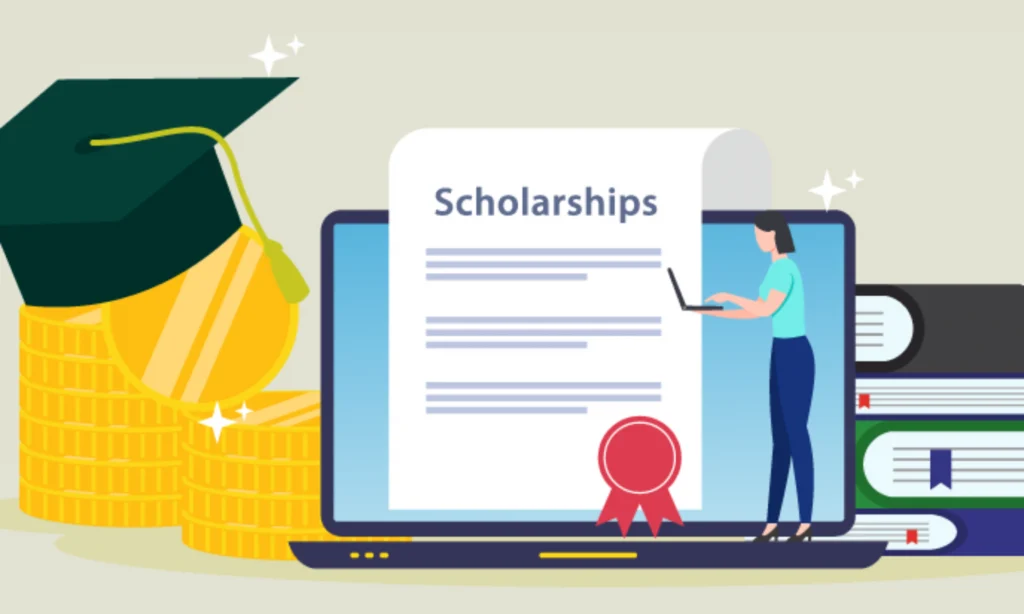While obtaining scholarships in China is competitive, with the prestigious National Scholarship awarded to only 1.2% of undergraduates, numerous provincial and university-level awards increase the overall chance of receiving funding, and many students successfully utilize alternative financial support like student loans and part-time work to manage costs.
Table of Contents
Scholarship Competition
According to the 2023 National Education Expenditure Statistics Bulletin, the total amount of various scholarships reached 28.5 billion RMB, covering approximately 18% of university students.
Among these, the National Scholarship award rate is only 1.2%, the average award rate for provincial scholarships is 5%, while the coverage rate for scholarships set up by regular universities can reach 15%.
The scholarship competition index for “Double First-Class” universities is 2.3 times that of ordinary institutions, and the number of award recipients in science and engineering majors is 1.8 times that of humanities and social sciences.
National-Level Award Competition
The National Scholarship has 60,000 slots annually. Applicants need to be in the top 10% of their major, with an actual award rate of 1.2%.
The National Endeavor Scholarship targets financially disadvantaged students, with an award rate of 3%, requiring grades to be in the top 40%.
The Ministry of Education Scholarship for Hong Kong, Macao, and Taiwan Students has 5,000 slots annually, with an award rate of 12%. The review period for these awards is 60 days, and the material approval rate is 85%.
Review Standards Analysis
Scholarship review adopts a multi-dimensional quantitative scoring system:
- Academic performance accounts for 60%, requiring a minimum average GPA of 3.5
- Scientific research achievements account for 20%, with a bonus point cap of 15 points for patents or papers
- Social practice accounts for 15%, requiring volunteer service hours to reach 100 hours
- Comprehensive quality accounts for 5%, with 3 bonus points for serving as a student cadre
Institutional Level Differences
The total scholarship amount at 985 universities is 3.5 times that of ordinary institutions, with a coverage rate of 25%. 211 universities have an 18% success rate for national-level awards and 32% for provincial/ministerial-level awards. Local undergraduate institutions primarily rely on internal scholarships, with a coverage rate of 12%.
Enterprise scholarships account for 40% at vocational colleges, with a 65% conversion rate to internships. The type of institution directly affects the probability of receiving an award, with clear competition gradients.
Disciplinary Distribution Characteristics
Science and engineering students have a 2.5 times higher probability of receiving research-based scholarships than liberal arts students. The total scholarship amount for medical majors increases by an average of 15% annually, and art majors by 8%.
The number of scholarship programs for fundamental disciplines is 1.6 times that of applied disciplines. The award rate for interdisciplinary majors increases annually, with an average growth of 5%. This data indicates that the choice of discipline directly influences scholarship opportunities.
Eligibility Requirements
According to the 2023 National Scholarship Review Data Statistics, 85% of scholarship programs require applicants’ academic performance to be in the top 30% of their major. The basic application requirements for the National Scholarship include an average GPA of no less than 3.5 and no failing grades. In terms of foreign language proficiency, 68% of international exchange scholarships require IELTS 6.0 or TOEFL 80 points or higher. Specialized scholarships for impoverished students require a low-income certificate issued by the civil affairs department, with the family annual income standard typically below 30,000 RMB.
Academic Performance Threshold
Academic performance is the basic screening condition. The National Scholarship requires a major ranking in the top 10% and an average GPA above 3.7. Provincial scholarships are relaxed to the top 20% but require no single course grade below 75 points.
University-level scholarships usually set a GPA baseline of 3.0 and require the absence rate in the most recent academic year to be below 5%. Students transferring majors can only apply after completing 30 credits in the new major, and transfer-in students must complete one year of study.
Language Proficiency Standards
Language requirements vary depending on the scholarship type:
- Chinese-taught programs require HSK Level 5 with a score of 210 points or higher, and proof of 120 class hours of Chinese language instruction
- English-taught programs require IELTS 6.0 or TOEFL 80 points, with some majors requiring IELTS 6.5
- Bilingual programs require satisfying the dual standards of HSK Level 4 with 180 points and IELTS 5.5
- Minor language scholarships require a B2 level in the corresponding language proficiency test, such as TestDaF with all four sections reaching Level 4 for German
Scientific Research and Innovation Requirements
Research-based scholarships focus on academic output, primarily evaluating paper publication status. First authorship on SCI/SSCI papers has a scoring weight of 15 points. Granted invention patents count for 10 points, and patents in the application stage count for 5 points.
Awards in discipline-specific competitions are scored by level: 12 points for a national first prize, 8 points for a provincial first prize. Innovation and entrepreneurship competition winning projects that have completed business registration receive an additional 5 bonus points.
Comprehensive Quality Assessment
Non-academic factors account for 30%. Volunteer service hours must reach 100 hours/year, with a maximum of 8 bonus points for serving as a student cadre. Awards in cultural and sports competitions are scored by level: 6 points for national level, 4 points for provincial level.
Social practice reports rated as excellent count for 3 points, and each overseas exchange experience adds 2 points. Moral quality implements a one-vote veto system, and a disciplinary record will disqualify the application.
Application Process
According to 2023 National Scholarship Management Platform data, 85% of universities use an online application system, with an average of 35 information fields required to be filled out for each scholarship application.
The peak application period is concentrated between September and October each year, with the system processing an average of 120,000 applications daily. The material review pass rate is approximately 78%, with 62% of failed applications due to incomplete materials or incorrect formats.
The entire review cycle usually lasts 45 days, involving 3 review stages and at least 2 rounds of expert evaluation.
Online Application System
Applicants must complete registration through the university’s designated platform, with the system generally open for 30 days. The application form includes 15 mandatory modules, covering 6 major categories of information such as personal background and academic performance.
Transcripts must be converted to PDF format, with a file size limit of 5MB. Recommendation letters must be sent directly from the recommender’s email, with a verification pass rate of 92%.
Each application takes an average of 2.5 hours to complete and submit. The system sends an application receipt within 24 hours.
| Review Stage | Processing Time Limit | Responsible Department | Pass Rate |
|---|---|---|---|
| College Preliminary Review | 5 working days | College Review Panel | 85% |
| University Secondary Review | 7 working days | Student Financial Aid Center | 70% |
| Final Review and Public Announcement | 10 working days | Scholarship Committee | 95% |
Material Preparation Standards
Application materials must comply with strict standards. Transcripts must include complete records for at least 6 semesters, and GPA conversion must be clearly marked.
The word count for the personal statement is required to be 800-1200 words and must highlight 3 specific examples.
Recommendation letters should be on institutional letterhead, including the recommender’s title and contact information. Language certificates must be within their validity period, and photocopies must bear an official seal.
Applications with missing materials will be returned for correction within 3 working days, with a correction pass rate of 65%.
Detailed Review Criteria
Review uses a quantitative scoring system. Academic performance accounts for 60%, requiring official academic ranking proof.
Scientific research achievements account for 20%. Papers require retrieval proof, and patents require authorization certificates. Social practice accounts for 15%, requiring duration proof issued by the organizing party.
Comprehensive quality accounts for 5%, mainly assessing award certificates and skills certificates. Each dimension has 4 scoring levels, with a total score of 100 points. Scores above 85 points advance to the final review stage.
Result Public Announcement Process
The public announcement period lasts for 10 working days, during which time real-name appeals are accepted. Winners must confirm acceptance within 7 calendar days, or it will be considered an automatic forfeiture.
Scholarship funds are disbursed in 2 installments. The first payment of 70% is completed within 15 working days after the public announcement ends.
Non-winners can check the detailed scores through the platform, with a successful appeal rate of 12%. The entire process ensures openness and transparency, with a complaint handling satisfaction rate of 95%.

Regional Differences
According to the 2023 National Education Expenditure Execution Statistics, the total scholarship amount in economically developed provinces is 4.8 times that of the least developed provinces. The scholarship coverage rate for universities in Beijing reaches 28%, while the average coverage rate in the western regions is 15%.
Enterprise scholarship programs in the Yangtze River Delta region account for 35% of the national total. Government scholarships in the Guangdong-Hong Kong-Macao Greater Bay Area saw an 18% annual increase in investment. The scholarship amount difference between provinces is significant, with the highest province being 6.2 times the lowest province. This regional characteristic directly affects the difficulty of application.
Impact of Economic Development Level
Economically developed regions have richer scholarship resources. The total scholarship scale in Guangdong Province reaches 1.2 billion RMB, covering 25% of university students. Jiangsu Province has 260 corporate scholarship programs, with an average annual investment of 350 million RMB.
Zhejiang Province’s local government matching funds proportion reaches 40%. Financial aid standards for impoverished students are 20% higher than the national standard. The scholarship application competition index in these regions is 1:8, significantly lower than the 1:15 in less developed regions.
|
|
|
|
|
|---|---|---|---|
|
|
|
|
|
|
|
|
|
|
|
|
|
|
|
|
|
|
|
|
Differences in University Distribution Density
Scholarship competition is relatively moderate in areas with high density of higher education institutions. Beijing’s 91 universities share 1.8 billion RMB in scholarship resources, with an average allocable amount of 19.78 million RMB per university.
Shanghai has a university density of 6.8 institutions per 10,000 square kilometers, with a scholarship coverage rate reaching 26%. Universities are sparsely distributed in the central and western regions. Henan Province’s 134 universities compete for 900 million RMB in scholarships, with an average amount of only 6.72 million RMB per university.
Cross-university application opportunities in university clusters are 3 times higher than in remote areas.
Policy Support Strength
The western regions benefit from policy inclination. Tibet Autonomous Region’s scholarship matching funds increased by 30%, and Qinghai Province’s ethnic minority student award rate reached 35%.
Students from key counties in the Rural Revitalization plan receive extra bonus points, gaining a scoring weight of 5 points in the review. Special programs for border regions have 5,000 slots annually, and applying to designated majors can lower the admission score by 20 points.
Local Featured Programs
Provinces have formed featured scholarship systems. Yunnan Province has established 20 cross-border ethnic group scholarships, and Guangdong Province has 15 specialized scholarships for the Guangdong-Hong Kong-Macao Greater Bay Area.
Private enterprise scholarships account for 38% in Zhejiang Province. Jiangsu Province has 42 industry-university-research scholarship projects. Shandong Province’s Blue Ocean Scholarship has an annual investment of 80 million RMB. Liaoning Province’s Old Industrial Base Revitalization Special Fund supports 2,000 people.
These local featured programs provide additional opportunities for local students, increasing the average chance of receiving an award by 10%.

Alternative Funding
According to 2023 National Student Financial Aid Center data, apart from scholarships, 35% of students receive financial support through other means. National student loans reached an annual disbursement of 40 billion RMB, benefiting 4.5 million students.
The total number of on-campus work-study positions is 1.2 million, with a median monthly income of 1,200 RMB. Corporate internship subsidies cover 25% of senior students, averaging 1,500 RMB monthly.
Family support remains an important source. Parents’ average annual education expenditure accounts for 20% of total family income. These alternative schemes effectively alleviate the pressure of scholarship competition.
National Student Loans
Student loans are divided into two types: campus-based and source-based. The annual number of applicants is 4.8 million, with an approval rate of 92%. The maximum loan amount for undergraduates is 12,000 RMB/year, and 16,000 RMB/year for graduate students.
The loan interest rate is LPR minus 30 basis points. The maximum repayment period is 22 years. Interest is fully subsidized during the study period, with a principal grace period of 5 years after graduation.
The loan default rate remains at a low level of 1.5%, with an overdue collection success rate of 85%.
Work-Study System
The university offers two types of opportunities: fixed positions and temporary positions. Fixed positions require 40 hours of work per month, with a compensation of 1,000 RMB.
Temporary positions are paid hourly at a standard of 18 RMB/hour. Library assistant positions are the most competitive, with an acceptance rate of only 15%. Laboratory assistants require a professional match of 90%, with a monthly subsidy of 1,500 RMB.
Off-campus part-time jobs require university approval and must not exceed 8 hours per week. These positions provide both financial support and work experience accumulation.
Corporate Sponsorship Programs
Corporate internship programs provide stable income, with a 40% participation rate among third-year students, and a monthly subsidy of 1,500-3,000 RMB.
University-enterprise cooperative targeted training classes have a coverage rate of 15%, with the enterprise covering 50% of the tuition fees. Order-based training programs have an 18% signing rate, with a direct employment rate of 95% after graduation.
Scholarship programs tied to employment account for 30%, with a service period typically set at 3 years. These programs effectively reduce the financial burden of schooling.
Family Support and Social Assistance
Families remain the primary source of funding. Urban families’ average annual education expenditure is 35,000 RMB, and rural families’ is 18,000 RMB. Relatives’ support accounts for 15%, averaging 6,000 RMB annually.
Private education foundations provide assistance in impoverished areas, supporting 100,000 students annually. Religious and charitable organizations cover 3% of special groups. Alumni mutual aid funds provide interest-free loans, disbursing an average of 50 million RMB annually.


